#nyuspecialcollections
Text
Surveying Spain: Working with Spanish Civil War Posters at NYU Libraries
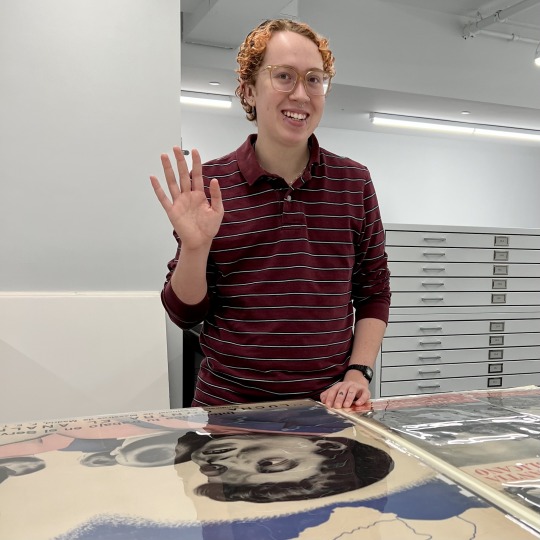
Hi, my name is Mia Lindenburg. I am a graduate student undergoing NYU’s Dual Degree program, where I will get an MA in literature and an MLIS. This semester, I have been working with NYU’s Barbara Goldsmith Preservation & Conservation Department, mentored by Lindsey Tyne (Conservation Librarian), Laura McCann (Director of Preservation), Weatherly Stephan (Head of Archival Collections Management), and Felix Esquivel (Collections Manager, Special Collections), to survey the Spanish Civil War Poster Collection (ALBA.GRAPHICS.001). This internship has helped me to prepare for a future career in special collections libraries, where I will be required to work with delicate material similar to what I see in this collection. I am very thankful for this opportunity and how it has allowed me to delve deeper into archival work with a hands-on approach.
In addition to working with the Preservation department, I have been lucky enough to work with the Archival Collections Management (ACM) and Special Collections departments, allowing me to see the different perspectives of handling a large and often complicated collection. This blog post will demonstrate the different ways in which these departments added to my learning experience and show some of the special facets of working with this collection in particular.
BUILDING THE DATABASE
Before I began surveying this collection, I had to create an infrastructure that would allow me to compile the data I would be collecting. I used the software AirTable to build this database. First, I had to move the data that had already been collected into my table. This came from Archives Space (AS), an archives information management software used by NYU Libraries. This had much of the preliminary data I would need to fact-check against in the survey, such as poster locations. After I had brought the AS data into the table, I created fields that would duplicate the AS fields but with the descriptor (survey) to show any differences. Additionally, I made new fields for things we might want to consider, such as condition and size.
UNIQUE POSTER FORMATS
“I tu? Que fas per la victoria?”

ALBA-ES 46, copy 4 “i tu?” (Photo by: M. Lindenburg)
The first set of posters that I want to discuss is ALBA-ES 45 and 46, also known as the two sides of “I tu? Que fas per la victoria?” a Catalan poster depicting a bloody soldier advocating for his audience to participate in the war, to support the cause. This collection has many copies, encapsulated (meaning this poster is inside a protective mylar sleeve) and unencapsulated, of this poster. The copies pictured below interest me because they were particularly delicate. You can tell from the photos that they were split into pieces, making flipping the posters to inspect the back difficult. These will need a lot of conservation work, although they may not be an immediate priority since so many copies are in fine condition.


ALBA-ES 45, copy 4 “i tu?” (Photos by: M. Lindenburg)
“Allisteu-vos a les milicies antifeixistes”
The poster “Allisteu-vos a les milicies antifeixistes,” belongs to a series of posters collected at The Franklin Institute in Philadelphia as part of a circulating exhibit.

ALBA-ES 116, recto, “Allisteu-vos a les milicies antifeixistes” (Photo by: M. Lindenburg)
These interest me because of how they were mounted for the exhibition. Rather than encapsulating the posters or leaving them untouched, this exhibitor chose to attach muslin across the back and use cardboard and grommets to hang them.
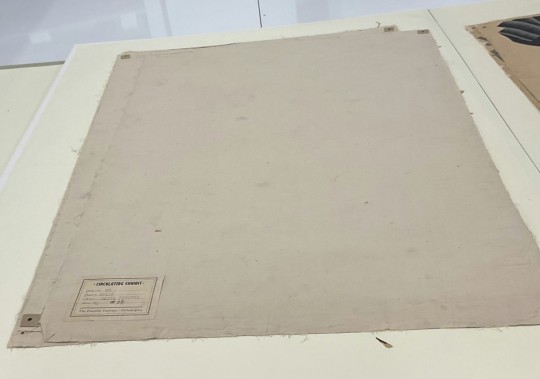
ALBA-ES 116, verso, “Allisteu-vos a les milicies antifeixistes” (Photo by: M. Lindenburg)
Annual Xmas Eve Ball
Poster ALBA-US-15, uses a mounting technique commonly used with posters associated with the Veterans of the Abraham Lincoln Brigade (VALB).
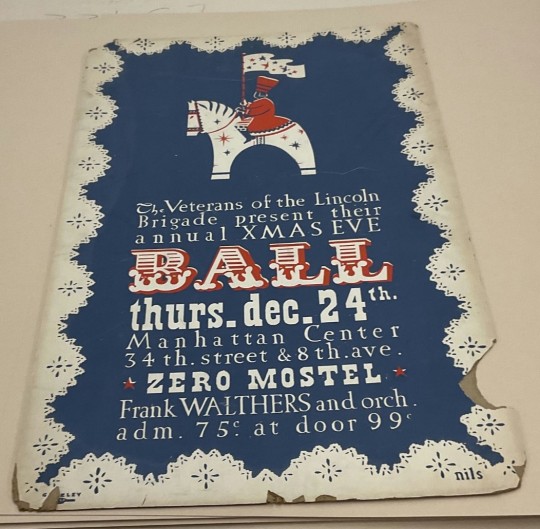
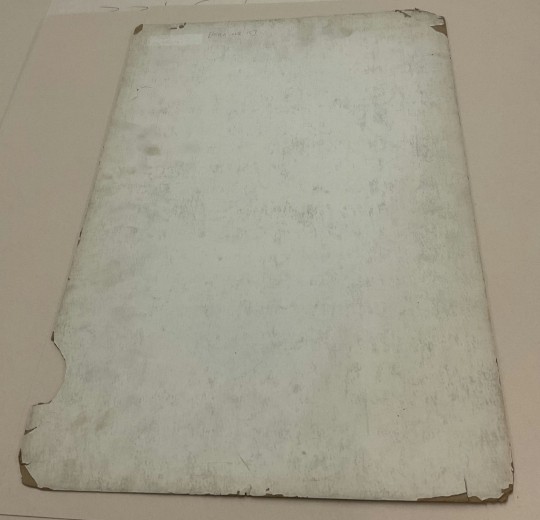
ALBA-US-15 (Photo by: M. Lindenburg)
It is mounted on a paperboard, which makes it somewhat heavy and unwieldy when grouped in folders. Take note of the headline of Zero Mostel, which shows the support the VALB received, even from celebrities.
THE INSCRIBED NAMES & WHO THEY WERE
Archie Brown is a signature I’ve encountered a lot in this collection.

ALBA-ES-8 (Photo by: M. Lindenburg)
Brown was born in 1911 in Sioux City, Iowa. He was brought into the world of labor activism at an early age. 1934, he was arrested at a Young Communist League (YCL) event in San Pedro. But he continued with his activism despite this. In 1937, Brown got tuned into the struggles in Spain, particularly after his brother was recruited to the International Brigade. In San Francisco, Brown was denied a passport because of his radical reputation. So, he went to New York City and stowed away on a ship to France, where he would travel to Spain. He joined the forces of the Abraham Lincoln Brigade and, even after the war, continued to fight as a soldier and an activist.

Archie Brown, 1982 (Photo by: R. Bermack). Image Source.
Harry Hakam is an interesting character, partially because of his frequent correspondence with other members of the Abraham Lincoln Brigade.
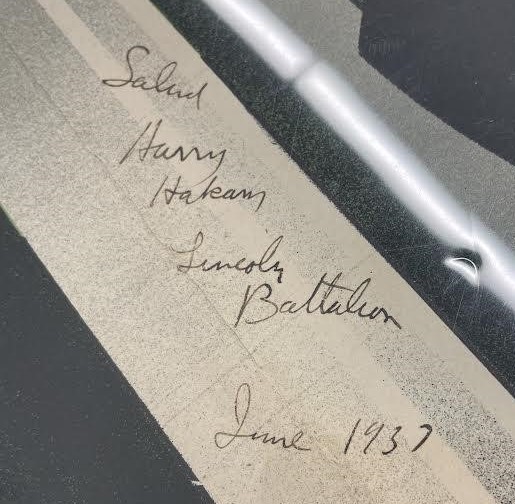
ALBA-ES-77 (Photo by: M. Lindenburg)
Hakam was born in Brooklyn in 1913. In February 1937, he sailed to France, arriving in Spain in March of the same year. He served primarily as a battalion runner, returning to the US in 1938. However, it’s his correspondence that makes him shine. His collection marker (Hakam) is found on many posters that share others’ names, meaning he likely sent these posters back and forth between fellow members.
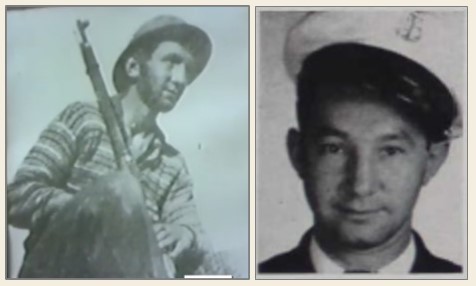
Harry Hakam. Image Source.
We don’t have as much information on Al Erdberg, but we do know from the Harry Hakam Papers (ALBA.046) and the fact that Erdberg shows up in the Hakam posters that they had correspondence. Erdberg was likely part of the Abraham Lincoln Brigade or a state-side supporter. This would be an interesting figure to research further.
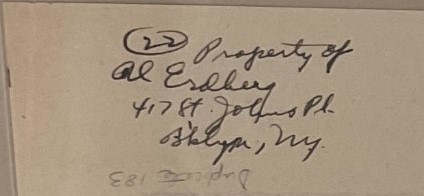
ALBA-ES-30 (Photo by: M. Lindenburg)
REHOUSING
A big problem I encountered when surveying these posters was with the housing rather than the posters themselves. Often, I encountered groups of ten or more posters in a folder, making the folder heavy and difficult to move. Further, if these posters are in mylar encapsulation, they become even heavier. To remedy this, the posters need to be rehoused into sturdier folders. I began some of this work with Laura McCann this semester, and the rehousing of the posters will continue through the summer.
VELCRO STICKERS
Some of the posters I found had velcro stickers left on the mylar encapsulation. These are likely from previous exhibition techniques, where the posters were attached to a wall using velcro. However, this technique is now deemed problematic, so Lindsey Tyne and I used a process to remove these stickers. We used a hot iron to heat small metal spatulas, which we then used to melt the adhesive of the sticker and lift the velcro off. This is a delicate process, but we got into a rhythm and moved fairly quickly.
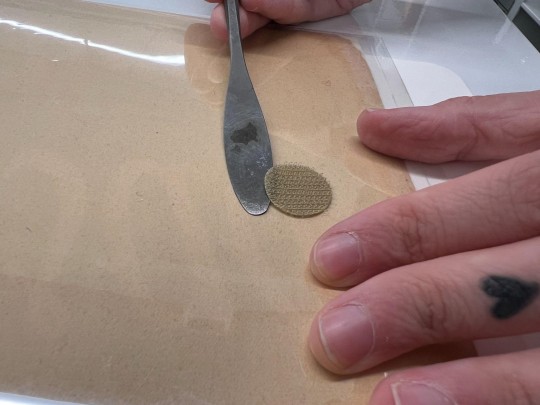
Mia removing velcro (Photo by: L. Tyne)
This collection has taught me many things. I have learned to be patient, think carefully, and always be on the lookout for new observations, among many other smaller skills. If I were asked to advise someone starting a similar project, I encourage them to take note of their natural rhythm so that they can figure out which order of surveying works best for them to maximize efficiency. I would also tell them not to be afraid of asking questions, even if it’s clarifying something they think you already know. This has been an incredible experience, and I feel so lucky to have been a part of this collection. Thank you for taking the time to read my post!
#nyulibraries#nyuspecialcollections#libraryconservation#paperconservation#librarypreservation#preservingthepast
27 notes
·
View notes
Text
Preserving Leaf Paintings in an Anglo-Indian Commonplace Book, 1822-1825
Hello, I’m Alexa Machnik, a third-year graduate student at the Conservation Center, Institute of Fine Arts, NYU. I first came to the Barbara Goldsmith Preservation & Conservation Department in Fall 2022 as a student in the graduate course, Conservation in Context, taught by Laura McCann, Director of Preservation. During this course, we delved into the world of library conservation, exploring the value systems that guide preservation decision-making and treatment action in academic research libraries. One of my class projects involved rehousing delicate leaf paintings from an early 19th-century commonplace book, or friendship album, part of the Fales Library holdings in the Special Collections at NYU Libraries (figs. 1-2) [1]. In honor of Preservation Week, I will share the intriguing history of the book and discuss the decisions that were made to preserve the leaves.

Figure 1 [left]: Front cover of the commonplace book, bound in gold-tooled red morocco leather.
Figure 2 [right]: Ownership label of “Jane Harriet [Blechynden]” on front marbled pastedown.
The book in question was compiled by Jane Harriet Blechynden (1806-1827) in England between 1822 and 1825. It holds her personal collection of handwritten and acquired materials, with contributions from her sisters, Emma and Sarah, who wrote original poems about sisterhood, separation, and their Anglo-Indian ancestry. The three women were the daughters of a British merchant residing in Calcutta, and while born in India, they were educated in England [2]. There is not a great deal known about Jane Harriet’s life in England, but her impending return to India in 1825 is documented in an emotional verse by Emma (fig. 3):
“Thus in parting my sister we’re breaking a link / Which may ne’er be united again / And firm as that chain was ‘tis painful to think / That absence may send it twain.”

Figure 3: Excerpt from the original poem, “Parting and a Meeting,” signed by Emma.
Jane Harriet’s book offers insights into her personhood, social connections, and sensibilities as an artist and collector. In addition to written entries, she inserted a compendium of acquired materials–pressed flowers, her own original drawings, and numerous paintings–between pages of the book (figs. 4-6).

Figures 4-6 [left to right]: A small sampling of the ephemeral treasures found in the book, including a dried pressed flower, a drawing on pith possibly by Jane Harriet, and a cut-paper silhouette.
Notably, six of these paintings are executed on the dried leaves of the Bodhi tree, a sacred plant indigenous to Asia with distinct spade-shaped, long-tipped leaves (fig. 7) [3]. Although leaf painting has origins in Buddhist traditions, by the time Jane Harriet collected her leaf paintings, it had already evolved into a form of Chinese export art in Europe. Her leaves depict secular scenes of contemporary life in China and botanical subjects, which are typical of the export genre (fig. 8). Their inclusion in the book implies that Jane was among the many people who partook in the avid collecting of China trade goods during the first few decades of the 19th century, a time when European fascination for Chinese culture and art was at its peak.

Figure 7: A leaf painting, as found loose in the book and partially lifted to show the thin, translucent nature of the leaf support.

Figure 8: Another leaf painting from the book, oriented with the leaf tip at the bottom of the image, depicting flowers and a butterfly.
The initial rush of excitement that I felt at finding the leaf paintings soon turned to concern as I gave thought to their long-term preservation at NYU Libraries, where researchers are expected to handle the book. The leaf paintings were loose in between the pages, which raised a series of “what ifs” about the potential dangers they could encounter. What if the leaves slip from the book? What if they bend or break as the pages are turned? What if the painted surfaces become abraded? The paintings were made with opaque pigment-based watercolors on exceptionally delicate, skeletonized leaves that have been primed with a thin organic coating. Despite being intact, their inherent fragility means that they are vulnerable to even the slightest touch. After considerable discussion, the Conservation Unit decided that in order for the leaf paintings to be preserved and safely accessed by researchers, they should be housed separately from the book.
I thoroughly examined the condition of the leaves and the painted surfaces in order to make a housing recommendation. Despite some minor damage, all were in stable condition. Thus, the ideal housing would provide support to prevent any further damage, such as paint loss and leaf breakage, and at the same time allow the leaves to maintain their translucency. To achieve this, I opted to mount them in double-sided window mats with a support made from clear polyester film, or Mylar® [4]. The addition of the Mylar® would not only create a stable surface for the leaf paintings but also enable the viewing of both sides (fig. 9).
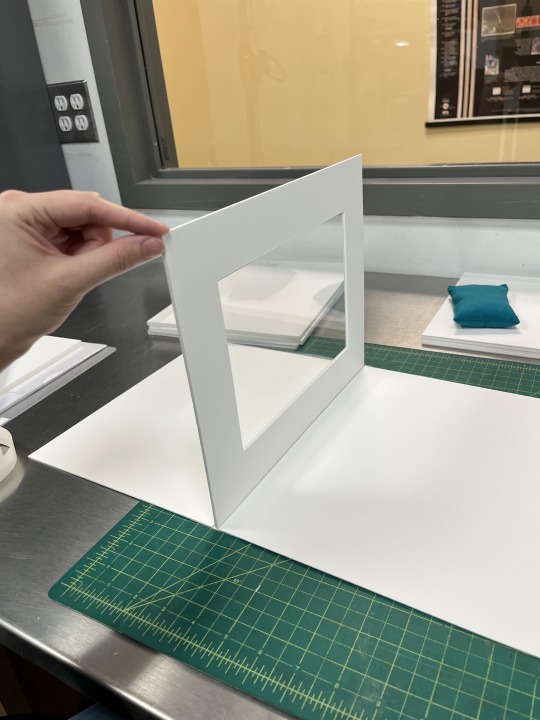
Figure 9: View of the double-sided window mat with a Mylar® support.
My next challenge was to figure out how to mount the leaves onto the Mylar® support without the use of adhesive [5]. After consulting with conservation staff and creating mock-ups, short, discreet Mylar® tabs were selected as the best option to secure them into place (figs. 10-11). For this process, I positioned a single leaf painting onto the support and selectively placed the tabs around its perimeter, making sure the tabs did not overlap any areas of paint. I then used a handheld spot-welding pen to fuse the tabs to the support. Since this process was done in-situ, near the leaf, it required lots of precision practice and encouragement from colleagues before I felt confident enough for the task.

Figure 10: Detail of a mounted leaf painting. Notice that the Mylar® tabs are welded just outside the leaf and extend minimally over the edges, holding it in place with gentle pressure.

Figure 11: The backside of a mounted leaf painting viewed through the Mylar® support. This gives researchers access to the painting’s verso, where an underdrawing and other signs of artistic process can be discerned.
At the time of writing this post, I successfully housed the six leaf paintings in their double-sided window mats (figs. 12-13). This housing project, while complete, is just one part of the ongoing effort to preserve the commonplace book, and the Conservation Unit is continuing work on other elements of the book to ensure its safe return to Special Collections.
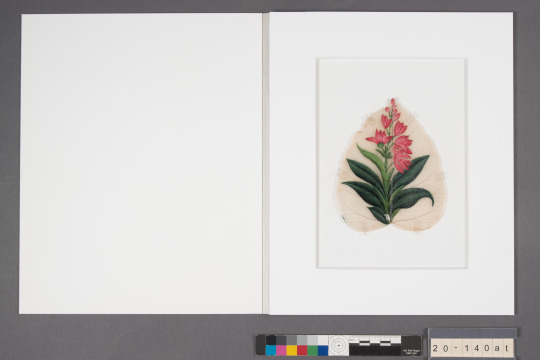
Figure 12: Example of the completed housing, showing the front of a leaf painting.

Figure 13: Back of a leaf painting.
Though my involvement in the project has come to an end, I have gained a very special appreciation for the commonplace book and the preservation challenges it presents. The experience of learning directly from NYU Libraries Special Collections was especially invaluable, providing me with opportunities to participate in complex decision-making processes unique to large research libraries driven by user needs. Before signing off, I’d like to extend my gratitude to my supervisors, Laura McCann, Director, and Lindsey Tyne, Conservation Librarian, and the entire team at the Barbara Goldsmith Conservation Lab for their unwavering support and enthusiasm throughout this project. Thank you all very much!
Notes:
[1] A commonplace book is a centralized place for an individual to record information, whether it be their personal thoughts or quotes from outside literary sources. Friendship albums, by contrast, contain handwritten entries from the family, friends, or acquaintances of the owner (often female). Both forms of commonplacing sustained popularity in Europe and America throughout the 19th century. To learn more about this fascinating literary genre, see Jenifer Blouin, “Eternal Perspectives in Nineteenth-Century Friendship Albums,” The Hilltop Review, Vol. 9, Issue 1 (2016) and Victoria E. Burke, “Recent Studies in Commonplace Books,” English Literary Renaissance, Vol. 43, No. 1 (2013), 153-177.
[2] Much of what is known about Jane Harriet (also known in her family as Harriet) comes from the Blechynden papers in the British Library (Add. Mss. 45578-663). This large holding contains the diaries of her father, Richard (Add. Mss. 45581-653), and older brother, Arthur (Add. Mss. 45654-61). For a secondary account of the Blechynden household, see Peter Robb, Sentiment and Self: Richard Blechynden’s Calcutta Diaries, 1791-1822 (New Delhi: Oxford University Press, 2011).
[3] Michele Matteini, “Written on a Bodhi tree leaf,” Anthropology and Aesthetics, Vol. 75-76 (2021), 45-58.
[4] The design of the double-sided mats is based on an instructional guide made available by the Library of Congress. “Double-Sided Mat,” Library of Congress, accessed 1 February 2023.
[5] We chose not to use adhesives or traditional paper-hinging techniques to mount the leaf paintings for several reasons. As noted, the paintings are on fragile, non-paper-based supports that have an organic coating, which may be derived from plant gum. The leaf supports are thin, translucent, and highly vulnerable to breakage, so applying hinges directly with adhesive might permanently alter their appearance or risk further damage to the leaves over time, especially if they need to be removed from the housing in the future.
Photographs: Alexa Machnik
#NYULibraries#NYUSpecialCollections#FalesLibrary#nyuifa#nyuart#librarypreservation#libraryconservation#collectionscare#artconservation#paperconservation#bookconservation#artpreservation#preservingthepast#PreservationWeek#preservationweek2023
210 notes
·
View notes
Text
"Azul" Print Comparison
This blog post for Preservation Week was contributed by media preservation graduate assistant Adrianne Lundy about her work on the Roland Legiardi-Laura and Joanna Kiernan Collection on the Azul Documentary (TAM.814).
Azul was directed by Roland Legiardi-Laura in 1988. The film focuses on Nicaraguan poetry and culture, celebrating the 100th anniversary of Ruben Dario’s published book of the same title. In 2022, NYU Special Collections acquired Azul’s many production materials, including raw footage and audio recordings.
Included in these acquired materials were nine separate prints of the film. All were assumed to be exhibition prints, based on their labeling and because they were housed in travel carriers used to ship prints to exhibitors. It’s not uncommon for duplicate materials to exist in a collection. However, maintaining duplicates means committing storage, funds, and resources that could otherwise be devoted to original elements of other collections. Exhibition prints also tend to have high rates of damage from projectors, abundant handling, and travel wear and tear. It was decided that these prints should be inspected and assessed to identify the best quality prints of the bunch.
The inspection of all nine prints took place in March and April of this year. The film is 105 minutes, and each print consisted of three reels. I made notes on key condition points, including the number of splices and level of shrinkage. A common form of damage across many of the prints came from misloading projectors or from DIY-ed projection marks. On two different occasions, the first ~100 feet of image on the first reel were heavily scratched, contained damaged perforations, and edge damage, but contained very little damage going forward. This is as if a projectionist had improperly loaded the film, stopped, corrected, and reloaded.
On other occasions, the projection marks varied in how they were implemented. Oftentimes individual projectionists/venues would have their own systems for indicating that a reel change was needed. On a number of prints, the heads and tails of the reels were painted white, presumably to indicate this.


On other occasions, one or two frames were cut and re-spliced into the film. This was likely a result of the three reels being edited together onto one reel for easier projection, and then separated again when the print was returned.


Another common issue across almost all prints were high levels of shrinkage. Most prints were found to have shrunk by 0.3% or more. Prints with 0.5% or higher shrinkage were noted as unsuitable for projection.
In inspecting the films, it was found that some prints were subtitled in English, while others were not. For this reason, a “best copy” was sought of each of these two versions. The two unsubtitled copies had the most vibrant colors of all the nine prints. Both were printed on Eastman 7243 Safety Stock, a stock used for color master positives. The stock type, plus the lack of subtitles, indicates that they may be of an earlier generation than the rest of the prints in the collection. One was in excellent condition, while the other suffered from projector damage and shrinkage over 0.5%, making the choice of “best copy” simple.




The remaining seven prints all had subtitles and were all marked as “Low-Fade Positive Prints” (LPP). Though this stock was created to prevent color fading (in response to earlier color stocks that were susceptible to fading to a magenta color), the colors of these prints often appeared a bit duller in comparison to the 7243 prints. Despite this, there was one film that registered as having 0% shrinkage, along with a minimal number of splices.
Additional repairs will likely still be needed on these prints. The subtitled print was one of the versions with projector damage at the head, though the rest of the film is in very good condition. Though no perfs were broken, many were bent and damaged. The non-subtitled version has an improper tape splice halfway through the second reel that is collecting dust and grime. Despite this, it was wonderful to identify two minimally damaged prints to represent these two versions of Azul.
#preservationweek#nyulibraries#PreservationWeek2024#nyuspecialcollections#Azul#filmpreservation#16mm film
6 notes
·
View notes
Text
Preservation Week 2023
Virtual Presentation: Conservation of Balinese Shadow Puppets from the Mabou Mines Archives
Date: Tuesday, May 2, 2023, 1:00 - 2:00 PM (EST)
Location: Virtual Event/Zoom
Registration: https://nyu_preservation_week_2023.eventbrite.com
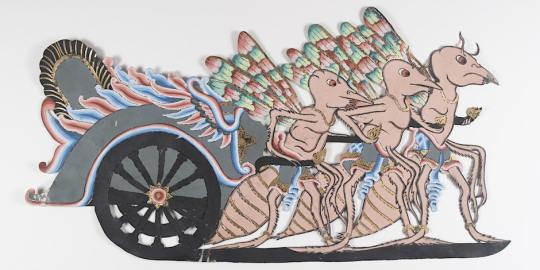
Image: a Balinese shadow puppet from the Mabou Mines Archive, NYU Special Collections.
Since last November, Conservation Center student Peiyuan Sun has been conducting research and conservation treatment on a group of Balinese shadow puppets from the Mabou Mines Archive (MSS.133). In this presentation, she will talk about the information that she has discovered regarding the history and manufacture of these materials and the ways in which she is actively working to make these items more accessible to future users.
Peiyuan Sun received her B.A. in Art History from NYU in 2018. She is in her final year at NYU’s Institute of Fine Arts, where she is a candidate for an M.A. in Art History and M.S. in Conservation of Historic and Artistic Works. Since fall 2022, Peiyuan has been working as an Andrew Mellon Fellow at the Barbara Goldsmith Preservation and Conservation Department for her curriculum internship under the supervision of Preventive Conservator Jessica Pace.
This event is presented in celebration of Preservation Week, an annual initiative of the American Library Association aimed at connecting our communities through events, activities, and resources that highlight what we can do, individually and together, to preserve our personal and shared collections.
#PreservationWeek2023#PreservationWeek#NYULibraries#NYUSpecialCollections#FalesLibrary#nyuifa#nyuart#librarypreservation#libraryconservation#collectionscare#artconservation#artpreservation#preservingthepast
27 notes
·
View notes
Text
Preservation Week 2024
Virtual Presentation
Go Violets!: The History & Conservation of NYU’s Yearbook Collection
Date & Time: Wednesday, May 1, 2024 · 11 AM - 11:45 AM EDT
Location: Virtual
RSVP: eventbrite
Event Series: NYU Libraries Preservation Week 2024

In celebration of Preservation Week 2024, the Barbara Goldsmith Preservation & Conservation Department is hosting a virtual presentation exploring NYU Libraries’ extensive yearbook collection. The collection contains almost 1000 yearbooks dating from 1887 to 2012 issued by New York University and its component schools. It is one of the most heavily used collections in the New York University Archives. University Archivist Janet Bunde will discuss the history and use of the collection, and Special Collections Conservator Dawn Mankowski will discuss conservation treatment and her recent survey of the collection that will be used to guide our preservation priorities and ensure continued access to this important record of NYU history.
Collection Information:
https://findingaids.library.nyu.edu/archives/mc_304/
Janet Bunde (she/her) is the University Archivist in the Special Collections Department at NYU Libraries where she is dedicated to the stewardship and preservation of the collections. Janet holds a BA in history with a concentration in peace and conflict studies from Haverford College, and an MA in history with a certificate in archival administration from New York University.
Dawn Mankowski (she/her) is a Special Collections Conservator in the Barbara Goldsmith Preservation & Conservation Department at NYU Libraries where she cares for and carries out conservation treatment on NYU’s library and archival collections. Dawn holds a BA in Art History and Anthropology from the University of Arizona, and an MA in the Conservation of Art from SUNY Buffalo State College, specializing in Library and Archives Conservation.

#PreservationWeek2024#PreservationWeek#NYULibraries#NYUSpecialCollections#librarypreservation#libraryconservation#collectionscare#paperconservation#bookconservation#preservingthepast
2 notes
·
View notes
Text
Scenes of the City: The Production and Preservation History of Films from the George Amberg and Robert Gessner Papers
by Michael Grant
This week we published a piece on our special collections blog, The Back Table, detailing our work on a collection of hundreds of short actuality films of New York City c. 1952. Shot in stunning black and white by Richard Leacock for an NYU promotional film (titled simply New York University) by Willard Van Dyke, the films present surprising, candid, often delightful views of the city at mid-century.
Read more about the project, and enjoy some of the films below!
https://wp.nyu.edu/specialcollections/2020/04/28/scenes-of-the-city-the-production-and-preservation-history-of-films-from-the-george-amberg-and-robert-gessner-papers/
These films are part of the George Amberg and Robert Gessner Papers (MC.199), held by NYU Special Collections.
youtube
“Spaghetti Joint” (MC.199, ref642-198)
youtube
“Polish & Sweep” (MC.199, ref578 & ref680-313)
youtube
Pedestrians crossing the street (MC.199, ref563-081)
youtube
Traffic on FDR Drive (MC.199, ref661)
6 notes
·
View notes